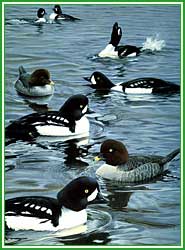 |
Barrows GoldeneyeBucephala islandica |
|
The Breeding of Barrows Goldeneye Finally Documented http://www.qc.ec.gc.ca/faune/sauvagine/html/nesting_bg.html Barrows Goldeneye Satellite Tracking Spring 1999 http://www.qc.ec.gc.ca/faune/sauvagine/html/satellite_bg.html Egg laying intervals and nutrient reserve use of breeding
female buffleheads and Barrow's goldeneyes. Parasitism, Population Dynamics And Hybridization In
Cavity- Nesting Seaducks Anderson, M.G., R.D. Sayler and A.D. Afton. 1980. A decoy
trap for diving ducks. J. Wildl. Manage. 44:217-219 Beil, C.E. 1974. Forest associations of the southern Cariboo Zone. British Columbia. Syesis 7:201-233. Bengtson, S.A. 1970 Location of nest-sites of Ducks in Lake Myvatn area, north- east Iceland. Oikos 21:218-229 Bengtson, S.A. 1971 Habitat selection of ducks broods in
Lake Myvatn area, north- east Iceland. Egg Laying Intervals And Nutrient Reserve Use Of Breeding
Female Buffleheads And Barrow's Goldeneyes This study was conducted to investigate nutritional aspects of reproduction in female Buffleheads (Bucephala albeola) and Barrow's Goldeneyes (Bucephala islandica) breeding in central British Columbia in 1993 - 95. Mean egg laying interval (Ò SE) for Buffleheads was 48.36 Ò 2.35 hr, which was similar to that of Barrow's Goldeneyes that laid, on average, every 45.32 Ò 1.40 hr. As a consequence of slower rates of egg production, daily energetic costs of reproduction in female Buffleheads and Barrow's Goldeneyes, evaluated relative to their basal metabolic requirements, are among the lowest documented for ducks. Patterns of lipogenesis differed between female Buffleheads and Barrow's Goldeneyes, but both species catabolized somatic fat during egg production. Buffleheads maintained stable body protein during reproduction, and thus relied exclusively on dietary protein for clutch formation, whereas Goldeneyes catabolized small amounts of somatic protein to produce egg protein during the 1993 breeding season. Use of body protein by a primarily carnivorous duck suggests that protein availability, i.e., invertebrate abundance, in breeding habitats used by Goldeneyes was periodically deficient. Somatic mineral supplied approximately 8% of clutch minerals in Buffleheads and 3% of clutch minerals in Goldeneyes during the 1993 breeding season, but neither species used endogenous minerals for eggshell production in 1994. Size of somatic lipid and protein reserves apparently did not limit clutch size in either Buffleheads or Barrow's Goldeneyes. Furthermore, clutch size was apparently not constrained by size of somatic mineral reserves in Buffleheads. However, body mineral mass was positively related to clutch size in Barrow's Goldeneyes. Thus, from a nutritional perspective, our data suggest that size of mineral reserves may limit clutch size in Barrow' Goldeneyes, whereas relatively low rates of nutrient reserve use indicate that clutch size in Buffleheads may not be constained by size of these reserves. |
|
